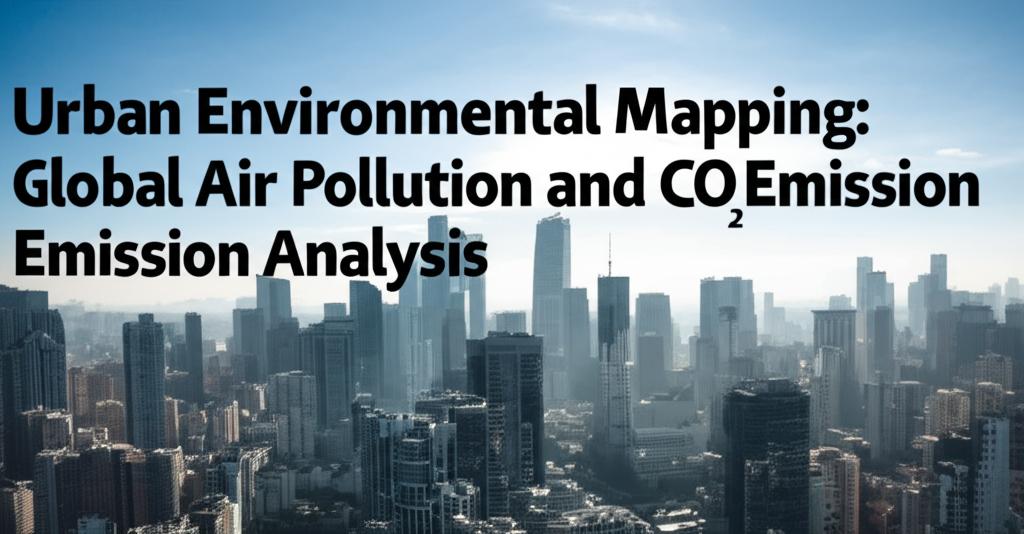Recent advancements in urban environmental mapping have significantly enhanced our understanding of global air pollution and CO2 emissions, particularly within city landscapes. Cutting-edge research leverages a combination of satellite observations, ground-based measurements, and sophisticated computer models to provide comprehensive analyses of urban environmental quality.
A noteworthy global study, encompassing over 13,000 urban areas, has meticulously mapped air pollution levels and carbon dioxide emissions. This research, conducted over the period of 2005-2019, offers a detailed snapshot of how urban environments are evolving worldwide. It highlights regional disparities, revealing that while some cities are experiencing cleaner air over time, others, particularly in regions with rapid population and economic growth like South Asia and parts of Africa, are seeing rising pollution and emission levels. Conversely, urban areas in high-income regions with proactive environmental policies have demonstrated simultaneous declines in various pollutants. A key finding of this study is that in over half of the cities analyzed, there are clear links between different pollutants, suggesting common sources and the potential for integrated reduction strategies.
The significance of urban areas in the global carbon cycle is profound, with cities estimated to be responsible for approximately 70-76% of global CO2 emissions from final energy use. The drivers of these emissions are complex, involving population size, income levels, the stage of urbanization, and urban form. Future urban population growth is predominantly expected in developing countries, where per capita emissions are currently lower but are anticipated to rise with infrastructure development and lifestyle changes. This underscores the critical importance of how new urban areas are designed, constructed, and powered in shaping future global GHG emissions.
Innovative technologies and methodologies are continuously emerging to improve the accuracy and resolution of urban environmental mapping. Satellite remote sensing, for instance, presents an unprecedented opportunity to track pollution levels in cities globally. Systems like Sentinel 5P are utilized for their advanced capabilities in monitoring atmospheric gases, offering spatial resolutions that, while broader than some ground-focused satellites, are effective for analyzing emissions in complex urban environments where air quality can vary significantly. Researchers are also developing methods to estimate CO2 emissions from transportation by using CO as a proxy, leveraging the relationship between these two gases.
Furthermore, tools are being developed for high-resolution, bottom-up emission inventories in cities. These tools model key emission sources such as road traffic and residential heating, allowing for the simulation of emission reductions from specific policies or interventions. For example, studies are analyzing the impact of measures like introducing lower speed limits or replacing fossil-fuel heating systems with heat pumps. Mobile sensor networks, including those deployed on vehicles like Google Street View cars, are enabling hyper-local air quality mapping, capturing block-by-block variations in pollutants such as black carbon, nitric oxide, and nitrogen dioxide. This high-resolution data is invaluable for identifying pollution hotspots and informing targeted mitigation strategies.
The integration of data from various sources, including low-cost sensor networks and even citizen science initiatives leveraging smartphone technology, is expanding the capacity for comprehensive urban air quality monitoring. Advanced data analysis techniques, including machine learning and AI, are being employed to process vast datasets, predict air quality changes, and create detailed spatiotemporal air quality maps. Air quality monitoring apps provide real-time data to the public, empowering individuals and raising broader awareness.
These ongoing efforts in urban environmental mapping are crucial for policymakers, researchers, and climate advocates. They provide valuable tools for assessing the effectiveness of pollution reduction strategies, understanding the intricate dynamics of urban emissions, and advancing both climate and public health goals in an increasingly urbanized world. The development of interactive maps and dashboards further enhances the accessibility and utility of this critical environmental data.

